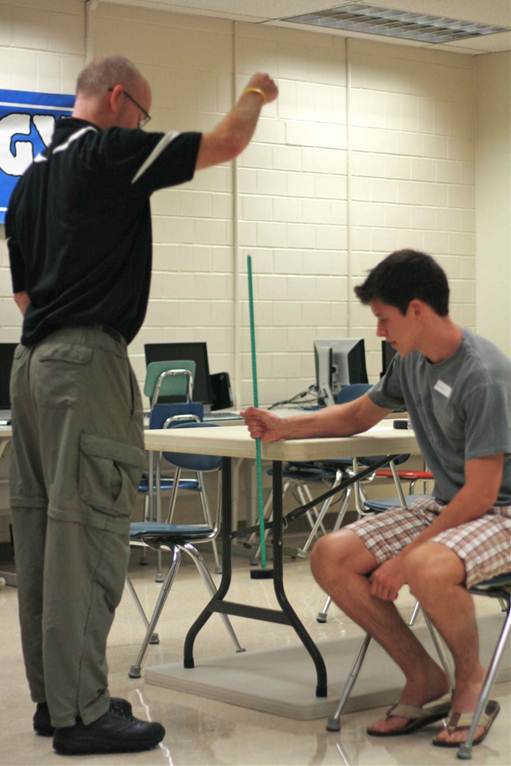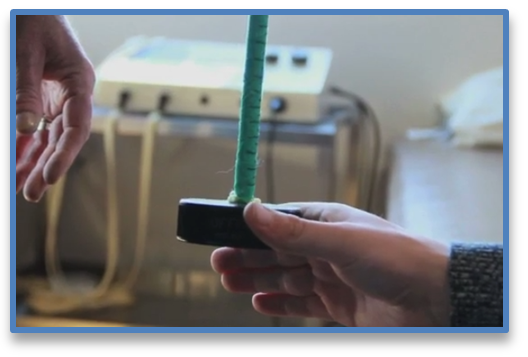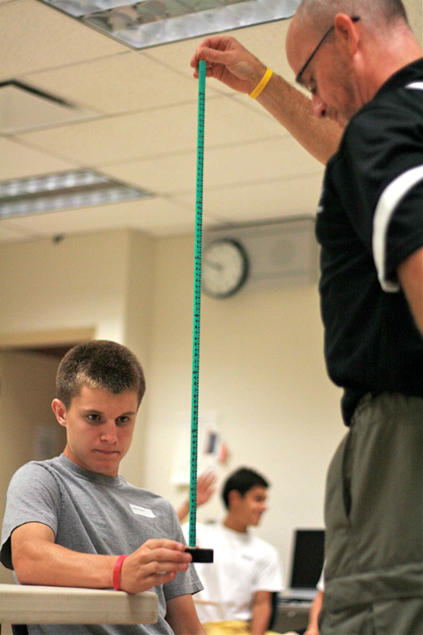Reaction time (RT) is commonly prolonged after a sport-related concussion. Besides being a marker for injury (e.g. one of the signs and symptoms of concussion), a rapid reaction time is necessary for protective maneuvers that can reduce the frequency and severity of additional head impacts.
Because prolonged reaction time (RT) is one of the signs of sport-related concussion, a reliable and valid measure of RT is important to a clinician's initial diagnosis and management of concussions, including return to play decisionmaking. Studies show that
- impairment of RT is seen post-concussion in college athletes9 and combined high school and college athlete populations.13
- for high school athletes, reaction time usually returns to baseline between three and twenty-one days post-concussion. 1-3
- boxers show prolonged RT compared to controls several days after symptom resolution.4
- prolonged RT is one of the strongest predictors of a longer recovery from concussion and ‘complex' concussions5
- RT is intrinsically related to athletic performance and secondary injury prevention.6
- Baseline computerized neurocognitive test (CNT) measures of RT have marginal reliability and should not be thought of as the sole measure for evaluating changes in RT post-concussion.7
Novel new test of RT
The Sideline-Dropstick test is a novel clinical test of reaction time using a device similar to one used in high school physics experiments and was initially developed by a group from the University of Michigan. 8,9,15

Studies show that it:
- is a valid and reliable RT measure for college athletes.10
- has good short- and long-term test-retest and inter-rater reliability.10,11
- correlates with sport-related protective response (such as, for example, the time it takes for a soccer player to raise their hands to protect the head from a rapidly approaching ball);6
- is intrinsically motivating (e.g. the motivation to do well on the test arises from within the athlete because it is intrinsically rewarding. 12
- correlates with computerized neurocognitive test measures of RT in baseline testing of college athletes.8
- appears to be sensitive to the effects of concussion and distinguished concussed and non-concussed athletes with similar sensitivity and specificity to other commonly used concussion assessment tools.15
- Given its simplicity, low cost and minimal time requirement, should be considered a viable component of the sports medicine provider's multifaceted concussion assessment battery.15
It should be noted that validation of the Sideline-Dropstick test in high school athletes is ongoing, but has not yet been done in middle school and younger athletic populations.14
Make Your Own
To administer the Sideline Dropstick you will need to build a dropstick and use a random number generator (there are several random number generator applications available for free download on smartphones)

Here's how to make a dropstick:
Supplies
- 7/16" dowel rod
- Rubber ice
hockey puck - Friction tape (what one would use for ‘grip tape' to tape a tennis racquet. Should be a light color. I have used "Tourna" Grip Tape, green colored, in my research).
- Standard push pin/thumbtack
- Power drill with 3/8 inch bit
- Wood saw and/or Leatherman tool
- Wood glue
- Superglue
- Felt tip marker (a black "Sharpie" with a fine point works well; you need one with ink that is easy to see against the friction tape)
Instructions
- Using the drill and 3/8 inch bit, drill into the puck, making sure not to drill all the way through.
- Remove the rubber shavings from the hole, put in a little wood glue, and then shove the dowel into the glue-filled hole.
- Wipe off the excess. (Sometimes you may need to shave down the very end of the dowel rod to get a good fit; a Leatherman's knife blade can be used for this).
- Allow the glued pieces to dry.
 Measure off 85 cm of dowel rod from the surface of the puck, and using the saw cut off the remainder of the dowel rod in excess of the 85 cm. A push pin should be easily inserted into the top of the dowel rod. We coat the push pin in superglue when we are putting the pin in to ensure it will not loosen easily.
Measure off 85 cm of dowel rod from the surface of the puck, and using the saw cut off the remainder of the dowel rod in excess of the 85 cm. A push pin should be easily inserted into the top of the dowel rod. We coat the push pin in superglue when we are putting the pin in to ensure it will not loosen easily.- Wrap the dowel rod from the base of the puck up to the top of the dowel rod in the friction tape.
- To mark the device, the surface of the hockey puck represents ‘zero.' Measure off 1 cm and ½ cm marks all the way to 80 cm. See the video above for details.
Administering the Sideline-Dropstick test
- To obtain a baseline, have the athlete sit comfortably next to a desk using their dominant (writing) hand in the position demonstrated in the video. They are given one practice trial.
- The test administrator then administers 8 recorded trials dropping the stick after a 2 to 8 second pause (use the random number generator each time to determine the time interval to drop).
- Record the distance dropped for each one of the eight trials. A simple equation can be used to convert the distance to time in milliseconds:8 RT (ms) = 1000x √(2 x distance in cm)/(980cm/s2). See the video for more details.









